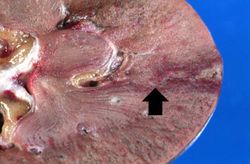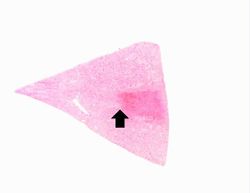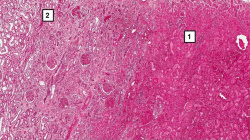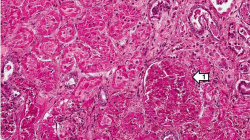Difference between revisions of "IPLab:Lab 1:Kidney Infarction"
(→Autopsy Findings) |
(→Images) |
||
| Line 4: | Line 4: | ||
== Images == | == Images == | ||
<gallery heights="250px" widths="250px"> | <gallery heights="250px" widths="250px"> | ||
| − | File: | + | File:IPLab1KidneyInfarction7.jpg|This gross photograph shows a kidney that has been transected longitudinally at autopsy. The triangular shape of an infarct is prominent on the right side of the image; the apex (arrow) of the triangle is evident at the corticomedullary junction. |
| − | |||
File:IPLab1KidneyInfarction3.jpg|This low-power photomicrograph of the kidney illustrates a sharply demarcated area of red discoloration extending from the capsule to the cortical medullary junction (arrow). | File:IPLab1KidneyInfarction3.jpg|This low-power photomicrograph of the kidney illustrates a sharply demarcated area of red discoloration extending from the capsule to the cortical medullary junction (arrow). | ||
| − | File:IPLab1KidneyInfarction4.jpg|A higher-power photomicrograph shows the edge of this reddish area, illustrating coagulation necrosis (1) compared to the normal tissue (2). The necrotic | + | File:IPLab1KidneyInfarction4.jpg|A higher-power photomicrograph shows the edge of this reddish area, illustrating coagulation necrosis (1) compared to the normal tissue (2). The necrotic tissue in this hemorrhagic, red infarct is hypereosinophilic. Compare the tubules on the right with the normal tubules seen in the left-hand portion of the slide. Note the interstitial hemorrhage which is associated with vascular leakage within this necrotic region in the tissue. |
File:IPLab1KidneyInfarction5.jpg|This higher-power view of the infarct demonstrates retention of the tubular structure and cellular outlines. In the lower right-hand corner is a barely identifiable glomerulus (1). Note that, although the cellular architecture is retained, there are no nuclei within the renal tubular cells. The nuclei visible in this photomicrograph are the nuclei of inflammatory cells. | File:IPLab1KidneyInfarction5.jpg|This higher-power view of the infarct demonstrates retention of the tubular structure and cellular outlines. In the lower right-hand corner is a barely identifiable glomerulus (1). Note that, although the cellular architecture is retained, there are no nuclei within the renal tubular cells. The nuclei visible in this photomicrograph are the nuclei of inflammatory cells. | ||
| − | File:IPLab1KidneyInfarction6.jpg|This section, taken at the cortical medullary junction, illustrates a blood vessel | + | File:IPLab1KidneyInfarction6.jpg|This section, taken at the cortical medullary junction, illustrates a blood vessel which is filled with thrombotic material (arrow). This vessel has occluded an end artery resulting in ischemia and infarction. |
| − | |||
</gallery> | </gallery> | ||
Latest revision as of 21:14, 27 June 2019
Contents
Clinical Summary[edit]
This 48-year-old male died in a motor vehicle accident. An incidental finding at autopsy was a renal infarct which was reddish-tan in color, sharply delineated, and triangular in shape. The base of the infarct was located at the capsular surface and its apex at the corticomedullary junction.
Images[edit]
A higher-power photomicrograph shows the edge of this reddish area, illustrating coagulation necrosis (1) compared to the normal tissue (2). The necrotic tissue in this hemorrhagic, red infarct is hypereosinophilic. Compare the tubules on the right with the normal tubules seen in the left-hand portion of the slide. Note the interstitial hemorrhage which is associated with vascular leakage within this necrotic region in the tissue.
This higher-power view of the infarct demonstrates retention of the tubular structure and cellular outlines. In the lower right-hand corner is a barely identifiable glomerulus (1). Note that, although the cellular architecture is retained, there are no nuclei within the renal tubular cells. The nuclei visible in this photomicrograph are the nuclei of inflammatory cells.
Virtual Microscopy[edit]
Kidney Infarction[edit]
Normal Kidney[edit]
Study Questions[edit]
Additional Resources[edit]
Reference[edit]
- eMedicine Medical Library: Renal Cortical Necrosis
- eMedicine Medical Library: Acute Tubular Necrosis
- Merck Manual: Renal Cortical Necrosis
Journal Articles[edit]
- Domanovits H, Paulis M, Nikfardjam M, Meron G, Kürkciyan I, Bankier AA, Laggner AN. Acute renal infarction: clinical characteristics of 17 patients. Medicine (Baltimore) 1999 Nov; 78(6): 386-94.
Images[edit]
Related IPLab Cases[edit]
- Lab 4: Kidney: Atheromatous Emboli
- Lab 5: Kidney: Nodular Intercapillary Glomerulosclerosis
- Lab 6: Kidney: Glomerulonephritis
- Lab 6: Kidney: Acute Transplant Rejection
- Lab 6: Kidney: Chronic Transplant Rejection
| |||||
The normal fibrinogen level is 184 to 412 mg/dL.




